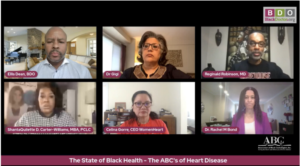
Dr. Gigi: The heart is not just a muscle. Can you provide a basic 101 education about the heart and what is heart disease?
Dr. Reginald Robinson: We can start by calling it the ABCs of heart disease. You can also add the D. The A is atherosclerosis or a plaque buildup in the heart, aneurysms, and sleep apnea. The B is for blood pressure, which is the most impactful medical condition to affect, in particular the African American population. When we move to the C, think about cholesterol, and congestive heart failure, and finally D, which most people don’t think about as a cardiovascular disease, is diabetes. We consider it a cardiovascular risk equivalent, and if you have diabetes, that’s just like having heart disease. Add in poor circulation which is called peripheral Arterial disease and it’s like a tree. If you have disease in the roots of the tree, you probably have it elsewhere. And that’s one way of looking at your cardiovascular health. If you have a stroke, you’re at higher risk of having a heart attack. If you have peripheral Arterial disease, you’re at higher risk of having a heart attack or a stroke. So it encompasses all of those different things. And more.
What is your organization and what is the role it plays between the patient and the healthcare provider?
Celina Gorre, CEO Womenheart: The number one thing that we at Womenheart do is to enable women to be their own best advocates. And that’s easier said than done. I think that what Womenheart does and does really well, is it provides women information like how different the symptoms may be in women who are experiencing heart conditions. We encourage women to
hold our healthcare providers accountable for all the processes of running all of the battery of tests. Including running a complete cardiac workup. The second thing that Womenheart does really, really well is provide other women who are going through their heart journeys, a community of women who’ve gone through it, just like they have. It turns out that that’s really, really critical in their journey from surviving a heart attack, to thriving with heart disease. And that’s the journey that we at Womenheart really love to support women through.
Theory says, eat right, exercise, you know, TLC, total lifestyle change.. How does that lifestyle change look and how does that play out in real life? And how did you find the support to be able to make that lifestyle change, to stay healthy and keep moving forward?
Dr. Carter-Williams: It is a challenge because if you’ve been doing something for so long, you’ve formed a habit. You have to break a habit. It’s really mindset, and the willingness to live. I joined a program called cardiac fit where there is a nurse practitioner there that I talk to on a weekly basis to make sure that I’m monitoring my blood pressure and any changes in heart. It also helps to have those conversations on a weekly basis. Hey, what are you eating today? What have you been eating this week? And then also admitting that sometimes I have bad weeks. FInd groups like Womenheart and American Heart Association to participate in and be really active with them. Have those open conversations about not only what you eat, but family history, and daily activity.
There are other physicians that offer input and information about heart health on this facebook live discussion. Click the link to hear more.
https://www.facebook.com/BlackDoctor.org/videos/506503314100309








